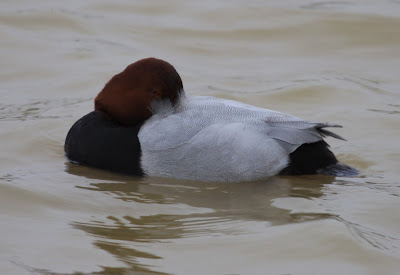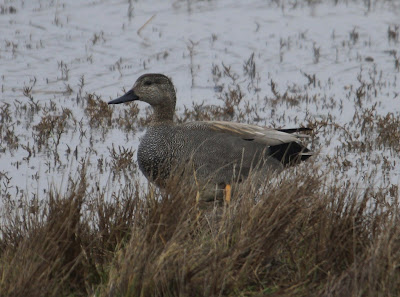I can't remember ever going out to specifically 'look' for Cetti's Warbler or Bearded Tit, two species that it would be easy to take for granted, as they are always there but still absent from the Year List this late in the day. With a forecast that suggested less than favourable conditions I was in the cemetery before the sun was but recording just double figures of Redwing and numerous Great Tits, quickly moved on to Radipole. There, completing one circuit of the Loop and noting that the water levels were positively Brisbanian , it was decide to retrace my steps. This time, nearing the end of the trail, the staccato song of one bird was heard, while another put in a brief appearance - 150 or what!
 Cetti's Warbler, a skulker if ever there was one, but
Cetti's Warbler, a skulker if ever there was one, but part of their extremely limited range in Great Britain are, fortunately, ever present just 5 minutes from my house. As for the Beardies, this was simply not their kind of day so gave them up until the sun starts to shine.
part of their extremely limited range in Great Britain are, fortunately, ever present just 5 minutes from my house. As for the Beardies, this was simply not their kind of day so gave them up until the sun starts to shine. Close to the Gurkha restaurant at the southern end of the lake. this Pochard appeared a little lethargic but nonetheless worthy of a shot,
Close to the Gurkha restaurant at the southern end of the lake. this Pochard appeared a little lethargic but nonetheless worthy of a shot, but of far more value as far as I'm concerned the Hooded Merganser
but of far more value as far as I'm concerned the Hooded Merganser was behaving perfectly providing another 'tick' in the box.
was behaving perfectly providing another 'tick' in the box.Over at Lodmoor, things were just as waterlogged but there were things to see especially the Long-billed Dowitcher, seemingly taken for granted by many these days, if I could locate it! Having already received a report from Daragh of Avocet, the said Dowitcher, Great Northern Diver etc there were even more addition to be had, but all there was of value on the sea wall were Roy and Muriel a lovely couple I see occasionally on my wanderings and love to talk to.
 Lapwing were numerous along with a single Redshank and
Lapwing were numerous along with a single Redshank and a few Dunlin also roosted and fed in the margins.
a few Dunlin also roosted and fed in the margins. Teal, this a male, and
Teal, this a male, and Gadwall, another male, both obliged with close up appearances, but then, there it was!
Gadwall, another male, both obliged with close up appearances, but then, there it was! The Long-billed Dowitcher was as close as I have ever seen it, and once I could hold the camera steady I fired off a couple of hundred shots.
The Long-billed Dowitcher was as close as I have ever seen it, and once I could hold the camera steady I fired off a couple of hundred shots. I make no apology for presenting it from every angle, as this rare American vagrant is a special bird indeed.
I make no apology for presenting it from every angle, as this rare American vagrant is a special bird indeed. Seen from from both left, right and here centre it also showed it's characteristic
Seen from from both left, right and here centre it also showed it's characteristic feeding technique which is often described as being similar to the needle of a sewing machine.
feeding technique which is often described as being similar to the needle of a sewing machine. I hope you enjoy these pictures half as much as I do, with this final rear view. Search as I may the Avocet never did reveal itself, but I was quite happy to view this
I hope you enjoy these pictures half as much as I do, with this final rear view. Search as I may the Avocet never did reveal itself, but I was quite happy to view this 'First winter' Common Gull with an
'First winter' Common Gull with an adult alongside for comparison.
adult alongside for comparison.At 11-30 precisely, the rain started. A light drizzle at first which soon developed into continuous light rain, it was time to go. Having not wished a number of my friends at the Swan public house a Happy New Year, what better excuse for a pint or two? These days I very much restrict my pub visits to JD Wetherspoon's but there was a time when I frequented every pub in Weymouth. but only on a daily basis! There, I was pleased to learn that landlady Kim had won yet another accolade, to add to her 3 'Pub of the Year' tally, having rightful received a 'Lifetime Achievement' award.
and harking back to my recent visits to various friends, while at Hugh & Janet's we enjoyed for dinner on that first evening roast pork from Pannage Pigs. From around the third week in September each year for a couple of months, the famous New Forest ponies, cattle and donkeys are joined by another group of animals – pigs. Commoners are allowed to let their pigs loose on the Forest to hoover up fallen acorns which are poisonous to ponies and cattle and can cause internal bleeding and death. The pigs also eat beech mast, crab apples and anything else they can find. From my point of view this represented the most succulent and flavoursome pork I have ever eaten. However, in traditional style for me I mistook the word 'pannage' for 'Panurge' with which I am familiar through a number of books and the music of Gentle Giant.
Panurge, a Giant, is one of the principal characters in the Pantagruel (especially the third and fourth books) of Rabelais, an exceedingly crafty knave, a libertine, and a coward. Simon Dupree and the Big Sound had massive success in the 60's with among others their classic hit 'Kites'. After this they changed their name to Gentle Giant and while enjoying some acclaim in the UK, pulled massive crowds in the USA and were, by and large, lost to these shores.
 Their first album simply titled Gentle Giant is something of an eye-opener, and while not definable to a particular genre their music is muli-instrumental, meaningful (in an occult sort of way) and exciting. My recommendation would be to start with this, but don't be slow to savour ALL the Giants (Pantagruel, Panurge et al) on the seminal second album
Their first album simply titled Gentle Giant is something of an eye-opener, and while not definable to a particular genre their music is muli-instrumental, meaningful (in an occult sort of way) and exciting. My recommendation would be to start with this, but don't be slow to savour ALL the Giants (Pantagruel, Panurge et al) on the seminal second album
 'Octopus'. I remember well my first 'live' encounter with these lads from Portsmouth as we embarked on a sojourn to see the incomparable (at the time) Groundhogs fronted by British blues legend Tony TS Mcphee. 'Giant' were placed second on the bill after mediocre Scottish outfit 'Train', when we were hit by a wall of sound - Zeppelin could have come out after that and still people would have left for home - they were that good! While '3 Friends', 'Acquiring the Taste' and 'In A Glasshouse' are among my favourite musical gems ever, this remains head and shoulders above them all!
'Octopus'. I remember well my first 'live' encounter with these lads from Portsmouth as we embarked on a sojourn to see the incomparable (at the time) Groundhogs fronted by British blues legend Tony TS Mcphee. 'Giant' were placed second on the bill after mediocre Scottish outfit 'Train', when we were hit by a wall of sound - Zeppelin could have come out after that and still people would have left for home - they were that good! While '3 Friends', 'Acquiring the Taste' and 'In A Glasshouse' are among my favourite musical gems ever, this remains head and shoulders above them all!
and harking back to my recent visits to various friends, while at Hugh & Janet's we enjoyed for dinner on that first evening roast pork from Pannage Pigs. From around the third week in September each year for a couple of months, the famous New Forest ponies, cattle and donkeys are joined by another group of animals – pigs. Commoners are allowed to let their pigs loose on the Forest to hoover up fallen acorns which are poisonous to ponies and cattle and can cause internal bleeding and death. The pigs also eat beech mast, crab apples and anything else they can find. From my point of view this represented the most succulent and flavoursome pork I have ever eaten. However, in traditional style for me I mistook the word 'pannage' for 'Panurge' with which I am familiar through a number of books and the music of Gentle Giant.
Panurge, a Giant, is one of the principal characters in the Pantagruel (especially the third and fourth books) of Rabelais, an exceedingly crafty knave, a libertine, and a coward. Simon Dupree and the Big Sound had massive success in the 60's with among others their classic hit 'Kites'. After this they changed their name to Gentle Giant and while enjoying some acclaim in the UK, pulled massive crowds in the USA and were, by and large, lost to these shores.
 Their first album simply titled Gentle Giant is something of an eye-opener, and while not definable to a particular genre their music is muli-instrumental, meaningful (in an occult sort of way) and exciting. My recommendation would be to start with this, but don't be slow to savour ALL the Giants (Pantagruel, Panurge et al) on the seminal second album
Their first album simply titled Gentle Giant is something of an eye-opener, and while not definable to a particular genre their music is muli-instrumental, meaningful (in an occult sort of way) and exciting. My recommendation would be to start with this, but don't be slow to savour ALL the Giants (Pantagruel, Panurge et al) on the seminal second album 'Octopus'. I remember well my first 'live' encounter with these lads from Portsmouth as we embarked on a sojourn to see the incomparable (at the time) Groundhogs fronted by British blues legend Tony TS Mcphee. 'Giant' were placed second on the bill after mediocre Scottish outfit 'Train', when we were hit by a wall of sound - Zeppelin could have come out after that and still people would have left for home - they were that good! While '3 Friends', 'Acquiring the Taste' and 'In A Glasshouse' are among my favourite musical gems ever, this remains head and shoulders above them all!
'Octopus'. I remember well my first 'live' encounter with these lads from Portsmouth as we embarked on a sojourn to see the incomparable (at the time) Groundhogs fronted by British blues legend Tony TS Mcphee. 'Giant' were placed second on the bill after mediocre Scottish outfit 'Train', when we were hit by a wall of sound - Zeppelin could have come out after that and still people would have left for home - they were that good! While '3 Friends', 'Acquiring the Taste' and 'In A Glasshouse' are among my favourite musical gems ever, this remains head and shoulders above them all!Then said he fair Pantagruel, my name is Panurge and I have come from Hell.
Great Britain Bird Year List 2011 - 151
